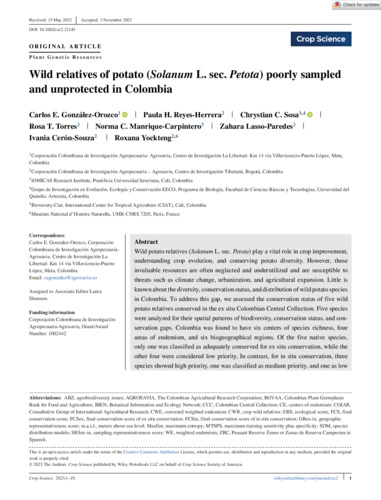Wild relatives of potato (Solanum L. sec. Petota) poorly sampled and unprotected in Colombia
Abstract Wild potato relatives ( Solanum L. sec. Petota ) play a vital role in crop improvement, in understanding crop evolution, and in conserving potato diversity. However, these invaluable resources are often neglected and underutilized, while susceptible to threats such as climate change, urbanization, and agricultural expansion. Little is known about the diversity, conservation status, and distribution of wild potato species in Colombia. To address this gap, we assessed the conservation status of five wild potato relatives conserved in the ex situ Colombian Central Collection. The five species were analyzed for their spatial patterns of biodiversity, conservation status, and conservation gaps. Colombia was found to have six centers of species richness, four areas of endemism, and six biogeographical regions. Of the five native species, only one was classified as adequately conserved for ex situ conservation, while the other four were considered low priority. In contrast, for in situ conservation, three species showed high priority, one was classified as medium priority, and one as low priority. In light of these findings, we propose three conservation strategies: (1) conducting collection missions to increase accessions in the national germplasm bank, prioritizing high‐priority species, (2) identifying and protecting unprotected natural habitats and engaging stakeholders to enhance in situ conservation efforts, and (3) establishing regional community genebanks to ensure localized conservation efforts. This article is protected by copyright. All rights reserved

